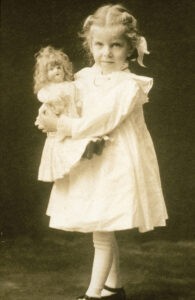Margaret Woodbury Strong
1897–1969
Born in Rochester, New York, on March 20, 1897, Margaret Woodbury Strong grew up an only child in a wealthy family of collectors. Her father, John Charles Woodbury (1859–1937), collected coins and recorded life events in scrapbooks. Her mother, Alice Motley Woodbury (1859–1933), collected 19th-century Japanese objects d’art. And an admired aunt collected bookplates.

The Woodburys provided Margaret with every advantage that money and social privilege enable. Her maternal grandfather, George Motley IV, owned a prosperous flour-milling business. Her paternal grandfather, Edmund Frost Woodbury, made a fortune in the buggy-whip industry. As early investors in the Eastman Kodak Company, the Woodburys’ fortunes grew alongside those of George Eastman, and their community status afforded Margaret many unique opportunities.
Thanks to her parents’ passion for traveling, Margaret saw more of the world by age 11 than most people do in a lifetime. On one six-month trip, she visited the beaches of Hawaii, played with dolls in a Japanese teahouse, rode an elephant in Ceylon, and toured the waterfronts of Shanghai, Hong Kong, and Canton. As an adult reflecting on her travels, she noted, “I was allowed to carry a small bag to put my dolls and toys in, and to add anything I acquired on the trips. Consequently, my fondness for small objects grew.” The Woodburys also spent considerable time visiting museums and attending the theater. In short, they made Margaret’s world into both a classroom and a playground.
An active child, Margaret enjoyed numerous athletic endeavors and later became an accomplished bowler and golfer. She also followed the social schedule dictated by the period and class to which she belonged. A comprehensive round of teas, dinners, and dances filled her calendar, and she faithfully catalogued mementos from these occasions in scrapbooks. Additionally, she pursued photography and received tutoring in languages, history, music, and art.

On September 9, 1920, at age 23, Margaret married Homer Strong, an attorney some 20 years her senior. They had one child, Barbara, born October 7, 1921. Barbara Strong began her education under tutors, later attended the Santa Barbara School for Girls, and subsequently graduated from Sarah Lawrence College. Like her mother, Barbara traveled with her parents and excelled in athletics. However, after two brief and unhappy wartime marriages, Barbara’s health failed and she died at age 24.
Homer died 12 years later. During her married life, Margaret had focused her attention on her family and on golf, gardening, garden clubs, garden parties, and competitive flower arranging. She had won golf tournaments and earned accolades in flower arranging, including a blue ribbon at the International Flower Show in New York City in 1939 and an invitation to exhibit at the World’s Fair that same year. After Homer died, however, she turned her attention and resources almost entirely to collecting, which she loved fiercely.
By the 1960s, Margaret’s collecting interests ranged so widely and her methods assumed such aggressive proportions that she had amassed more than 27,000 dolls and a seemingly endless number of middle-class American household objects spread over more than 50 categories. The vast majority of her collections, however, related in some way to play, and she earned a particular reputation for her outstanding collection of dolls and toys.
As her accumulation grew, Margaret began to think of her collections as a museum. To house her acquisitions, she added two gallery-like wings to her 30-room suburban Rochester residence. When people came to visit, she asked them to sign a guest book and record their impressions. In December 1957, the Rochester Times-Union reported on her dollhouses and noted, “These are only a few of the highlights of this stupendous collection which will soon be open to the children of Rochester and the general public.” A year later, the Rochester Historical Society sponsored the first public showing of the dollhouses, with 100 on view. Two months later, Hobbies—The Magazine for Collectors, publicized the event nationally.
In 1968 Margaret obtained a provisional charter from the New York State Board of Regents for the “Margaret Woodbury Strong Museum of Fascination,” a name she took from the way guests often described her collections. She planned to add another wing and a lecture hall to her home, but she never built them. On July 17, 1969, she died in her sleep at age 72.
In her will, Margaret left her collections and most of her financial resources for a museum, and 13 years later, in 1982, the Margaret Woodbury Strong Museum opened to the public at One Manhattan Square in downtown Rochester. Over the following two decades, the museum grew dramatically, expanding its collections, facilities, and resources. Now known simply as The Strong, it spans more than 285,000 square feet and serves global audiences on-site at the museum, online, and through the work of its International Center for the History of Electronic Games, the National Toy Hall of Fame, the World Video Game Hall of Fame, the Brian Sutton-Smith Library and Archives of Play, the Woodbury School, and the American Journal of Play.
For more information on Margaret Woodbury Strong, see also New York Heritage Digital Collections, which features The Strong’s Margaret Woodbury Strong Papers, 1897–1969 and nearly 70 images that document Margaret’s life and legacy.
 Hours 10 a.m.–5 p.m. | Fri. & Sat. till 8 p.m.
Hours 10 a.m.–5 p.m. | Fri. & Sat. till 8 p.m.